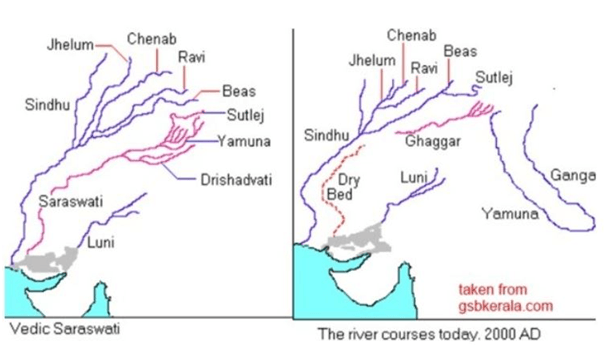
| SARASWAT BRAHMINS The
Saraswat Brahmins are a sub-group of Hindu Brahmins of India who
trace their ancestry to the banks of the Saraswati River.
The five (Panch) Gowd Brahman groups were Saraswats, Kanyakubjas, Gauds, Utkals, and Maithilas. The five (panch) Dravid Brahman groups were Andhras, Maharashtras, Dravidas or Tamils, Karnataka, and Kerala Brahmans.
The origin of Saraswat Brahmans :
The
exact origin of the Saraswat Brahmans is difficult to ascertain.
One theory puts them as Aryan (indo-iranian) migrants from Central
Asia who came to the Indian sub-continent through the Hindu-Kush
Mountains and the Khyber pass to south in about 4000-1500 B.C.
Most of them settled along the banks of Saraswati River. They (Saraswats) settled for an agrarian life. Education was of great importance to the Saraswats, so they taught their young the Sanskrit language and enlightened themselves from the Veda(s). Although they spoke Sanskrit in public, their invented a simplified version of Sanskrit called Brahmani and spoke only at home. Over the years along the Saraswati, they established the concept of Kul devta or family gods, and began worshipping them.
The Saraswat Brahmins :
Panch Gaur Brahmins (five classes of north Bharat) are :
1. Saryupareen 2. Kanyakubj 3. Maithil 4. Saraswat and 5. Utkal.
Saraswat from Uttarapath (Aryavart) (northern and eastern Bharat) are :
The Migrations
Some
calamity struck Saraswat Desh and Saraswati began to dry out
to become non-existent by 1000 BC. Saraswats had no choice
but to pack up and move. This period of history saw many civilizations
abandoning their settlements. The migration happened not overnight
but spread over centuries. The Saraswats migrated in three
directions - mostly followed the river routes and migrated
to the South-West (Sind), North (Kashmir), East (Bihar).
Migration to Bihar :
The Saraswats who moved South East were mainly from the Saraswat Desh and they followed the Ganges and reached Trihotrapur or modern Tirhut in upper Bihar. This was in 400-350 BC. The major settlements were in Kanyakubj (Kanpur area), Magadh and Mithila.
Saraswats of Punjab :
The Saraswat is essentially the Brahman of the Punjab, just as the Khatri is distinctively a Punjabi caste. |
